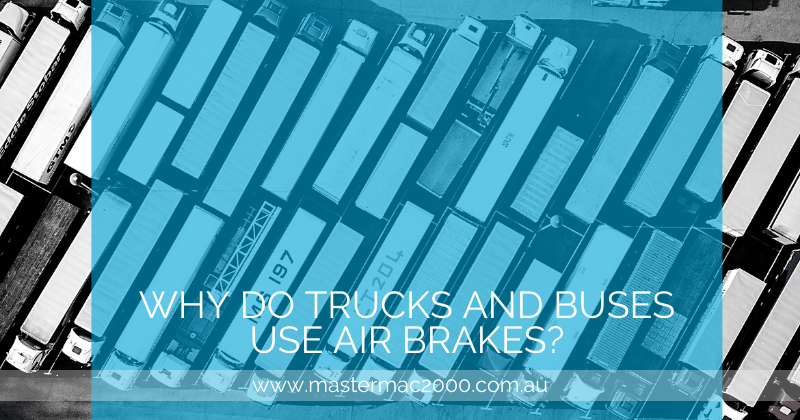Why Do Trucks and Buses Use Air Brakes?

The compressed air braking system is a type of friction brake for large vehicles, railroad cars, and other vehicles that carry heavy loads. Air brakes use compressed air that presses on a piston and then applies pressure to the brake pad to stop the vehicle. Air brakes use a pneumatic system or air rams rather than a hydraulic system.
Why Use Air Brakes for Heavier Vehicles?
Motor cars and smaller vehicles use a hydraulic system for its brakes. Compared to a heavier vehicle’s air rams or pneumatic valves in its air brakes, hydraulic brakes occupy less space and have fewer components in lighter vehicles.
Since trucks and busses are heavy, they require a large force to stop. With a hydraulic system, the driver has to exert more effort on the brake pedal to stop the truck or bus, which is next to impossible. Even with a brake booster, it will still be hard to push the pedal connected to the master cylinder or pneumatic valve and then to the callipers and brake disk.
Air brakes use compressed air because of its high potential energy. The compressed air keeps the engaging brakes open. When the driver steps on the brake, it is actually reducing the air pressure from the brakes, thus engaging the callipers again. Therefore, it doesn’t require much effort from the driver to step on the brake pedal.
Naturally, air brake systems are more expensive than ordinary hydraulic disk brake systems. This is because air brakes are more complicated, contains more components, and requires many processes when in use.
Who Invented the Air Brake?
The pneumatic air-brake system, sometimes called the triple-valve air brake system, was invented by George Westinghouse, an engineer. He realised the importance of safety in the new railroad industry at that time and designed the system to be used for railroad cars. Air brakes are a triple-valve system because:
- The brake must be charged – the system must be filled with pressurised air before the brakes will release. When a rail car or vehicle is stopped, the brakes remain engaged. To free the brakes so the vehicle can move, the system must be filled or pressurised again.
- As the brake is applied – the air pressure decreases. As this happens, the valve allows air back into the air tanks, while the brakes move to the applied position.
- After releasing – once the air escapes after breaking, the increased pressure releases the brakes.
Master Mac 2000
Master Mac 2000 is a proud Australian-owned distribution company since 1989 and stocks not only quality parts but also provides an excellent sourcing facility for ‘hard-to-get’ parts such as air rams, pneumatic valves, and pressure control valve systems. We provide quality brands such as Univer, Mack, Tolomatic, Piab, American, Rotoflux, and much more from our Brisbane facility. Call us now at 07 3344 4711 to discuss your needs or visit the MasterMac2000 site at https://mastermac2000.com.au/.

About MasterMac2000: Your Trusted Pneumatic & Process Automation Partner.
LEADING THE INDUSTRY: Established in 1989, MasterMac2000 has grown to become one of Australia's largest privately owned pneumatic and process automation companies. We stock top-quality brands like Univer, Mack, Tolomatic, Mac, Piab, American, and Rotoflux in Brisbane.
SERVING QLD & NORTHERN NSW: We proudly service Queensland and Northern New South Wales for all your pneumatic and process equipment needs. Our mission is to provide the best pre and post-sales support while actively expanding our client base.
SOURCING HARD-TO-FIND PARTS: Not only do we stock quality components, but we also excel at sourcing those elusive, hard-to-find parts. With our extensive database and global network of contacts, getting the parts you require is as easy as a call to our highly skilled, professional sales team.
DEDICATED TO YOUR SUCCESS:
- Decades of expertise in pneumatics & process automation
- Carefully curated selection of world-class brands
- Exceptional sourcing capabilities for speciality parts
- Knowledgeable sales staff dedicated to finding solutions
- Unwavering commitment to customer service excellence
About The Author
Stuart Havill
Stuart Havill is the owner and manager of MasterMac2000, Queensland's largest privately owned pneumatic and process valve company.
With his early working career as a maintenance fitter for Boral in 1992, Stuart has spent his life in the field of pneumatics and process equipment. He gained extensive experience in plant design, maintenance, repairs, fabrication, and site management.
In 1996, he transitioned to a pneumatic sales technician role at MasterMac2000, where he excelled in key account management, providing cost-effective solutions, and managing a sales team of 9 employees.
Since 2002, Stuart has been the manager at MasterMac2000, overseeing the company's growth and establishing it as a leader in pneumatic automation and process valve engineering. His expertise spans customer training, CRM setup, industrial compressor sizing and installation, and turn-key project management.
Under Stuart's leadership, MasterMac2000 has been servicing the industry since 1988, with 5 full-time sales representatives covering northern rivers NSW, Queensland, Northern Territory, and PNG. The company prides itself on providing the best-priced solutions to all customers in the marketplace.
View Stuart’s LinkedIn profile to learn more about his expertise in pneumatics and process equipment.